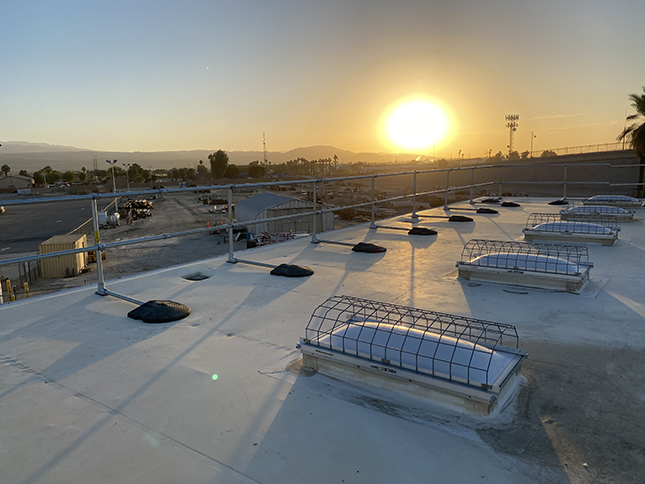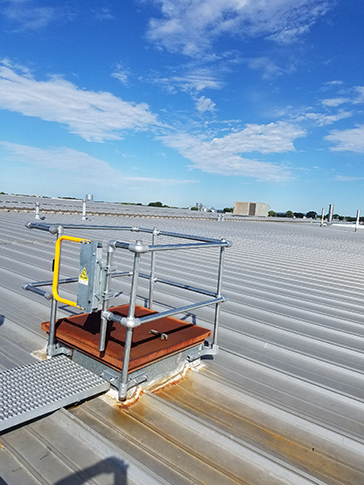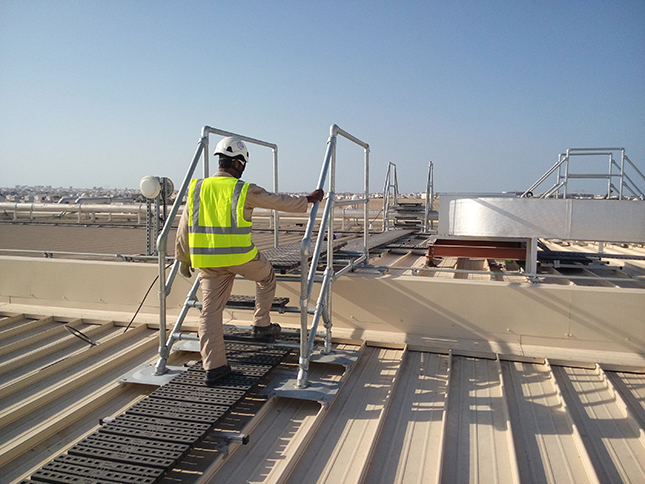1. Introduction: The Myth of the “Safe” Roof
Even a seemingly flat or unobstructed rooftop can hide a host of dangers. From deteriorating membranes to unguarded edges, what looks low‑risk often conceals serious fall and trip hazards. Safety managers tend to focus on obvious risks—guardrails, anchor points, warning lines—while overlooking everyday details that trip up workers. A thorough, systematic audit not only uncovers these blind spots but also empowers teams to take corrective action before incidents occur. Use this checklist to ensure no hazard goes unnoticed and to foster a culture of proactive rooftop safety.

2. Four Key Audit Categories
Structural Integrity
• Membrane Condition: Look for cracks, blisters, or punctures that can lead to water ingress and weakened substrate. Even small splits accelerate deterioration under foot traffic.
• Ponding Water: Identify areas where water accumulates—this increases slip risk and accelerates membrane breakdown. Ensure drains are clear and roof pitch is adequate.
• Roof Penetrations: Inspect around vents, fans, and HVAC units. Check for cracked seals or loose flashing that can cause leaks and unstable footing.
Edge Protection
• Guardrails & Handrails: Verify that railings meet OSHA/ANSI height and load requirements, with no loose posts or missing hardware.
• Warning Lines & Safety Zones: Confirm that warning lines are correctly placed at least 6 feet from unprotected edges and clearly marked with high‑visibility flags.
• Toe Boards & Kick Plates: Ensure toe boards are present where required to prevent tools or debris from rolling off the roof edge.
Anchor Points
• Certification & Load Ratings: Check each anchor’s inspection tag for valid load ratings and certification dates.
• Placement & Spacing: Confirm anchors are positioned to allow adequate coverage for lifelines or lanyards, minimizing free‑fall distance.
• Wear & Corrosion: Examine welds, hardware, and mounting plates for rust or fatigue that could compromise strength.
Trip & Slip Hazards
• Debris & Obstructions: Look for loose materials—tools, scrap metal, cable reels—that clutter walkways and create trip points.
• Cord & Hose Routing: Ensure power cords, air hoses, and condensate lines are secured off walking paths or routed through cable covers.
• Surface Conditions: Identify slick spots from algae, moss or chemical spills. Non‑skid coatings or gritted tapes can mitigate these risks.

3. Common Blind Spots & Quick Fixes
Skylights & Roof Hatches
Blind Spot: Workers often treat these as solid ground, risking falls through unguarded openings.
Quick Fix: Install collapsible guardrails or strongly secured covers rated for pedestrian traffic.
Parapet Corners & Step‑Downs
Blind Spot: Corners lack clear barriers or warning lines, tempting crews to work dangerously close to the edge.
Quick Fix: Add high‑visibility warning tape or install portable railing extensions to cover corner gaps.
Unmarked Elevation Changes
Blind Spot: Subtle transitions—such as from the main deck to a parapet—often go unnoticed, leading to twisted ankles or falls.
Quick Fix: Use contrasting color transition plates or adhesive warning strips to call out height differentials.
HVAC Zones & Equipment Platforms
Blind Spot: Condensate lines, power cabling and spare parts congregate around equipment, creating cluttered paths.
Quick Fix: Implement dedicated cable trays, install cable ramps over hoses, and establish “keep‑clear” zones.
Weather‑Related Hazards
Blind Spot: Ice, frost or wet moss can make roof surfaces unexpectedly slick, especially in shaded or north‑facing areas.
Quick Fix: Apply temporary non‑skid tape on routes or schedule work to avoid early‑morning thaw conditions.

4. Integrating Instant‑Result Digital Tools
Moving from paper‑based checklists to a mobile or web‑based audit tool transforms the process. An interactive platform allows inspectors to:
• Score Hazards On‑the‑Spot: Tap through predefined categories and automatically flag non‑conformances.
• Generate Instant Reports: Within minutes, teams receive a digital audit report complete with photos, hazard locations and recommended corrective actions.
• Track Corrective Actions: Assign tasks to responsible parties with due dates, ensuring issues don’t linger unaddressed.
• Analyze Trends: Aggregate data across multiple audits to identify recurring problem areas—enabling targeted training or design changes.
By providing instant feedback, these tools turn audits into actionable workflows, accelerating hazard remediation and strengthening accountability across the safety team.

5. From Audit to Continuous Improvement
A one‑off inspection is just the beginning. To drive real change:
• Schedule Recurring Audits: Set a quarterly or biannual cadence and track completion rates.
• Define KPIs: Monitor hazard‑closure rate and time‑to‑repair as key performance indicators.
• Link to Training: Use audit findings to shape toolbox talks and refresher sessions—closing knowledge gaps revealed on the roof.
• Review & Refine: Regularly update your audit checklist based on incident data, evolving standards and new roof configurations.
Transforming audits into an ongoing cycle of assessment, action and review embeds safety into your standard operating procedures—and keeps hidden rooftop hazards from ever catching you off guard.
Dan Huntington is an experienced sales and technical product trainer with a demonstrated history of working in the Fall Protection Industry. As a Fall Protection Industry Expert, he is formally trained in OSHA fall protection standards and risk assessment. He is a respected compliance educator and trainer in rooftop safety, presenting at the ASSP Expo for the International Society of Fall Protection (ISFP) where he facilitated a course on improving safety for people working at height. He recently presented at the Western States Roofing Contractors Association Expo. www.keesafety.com
|
